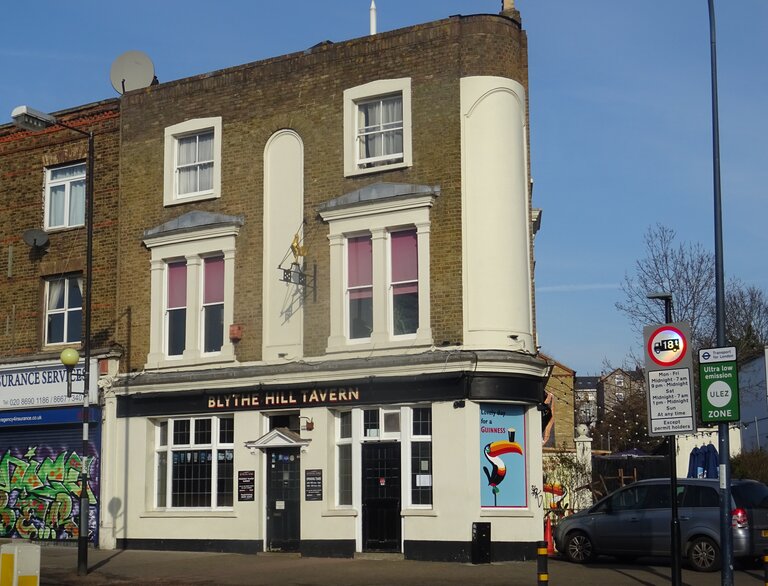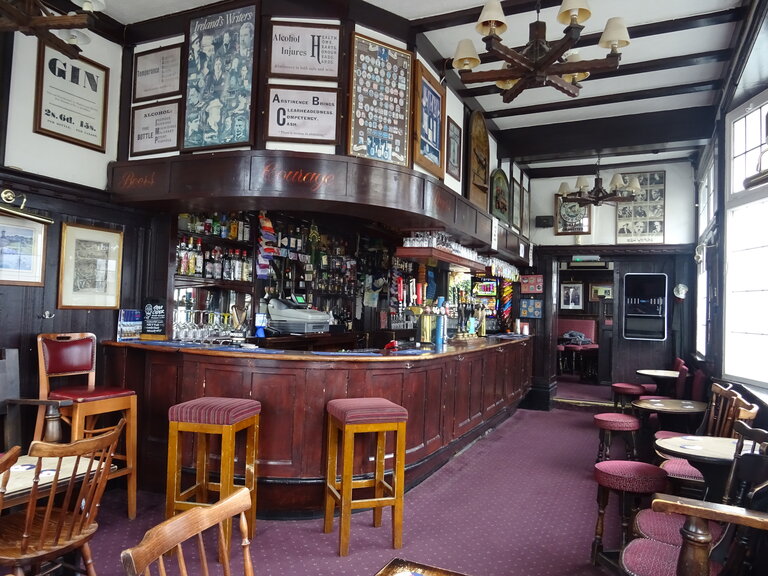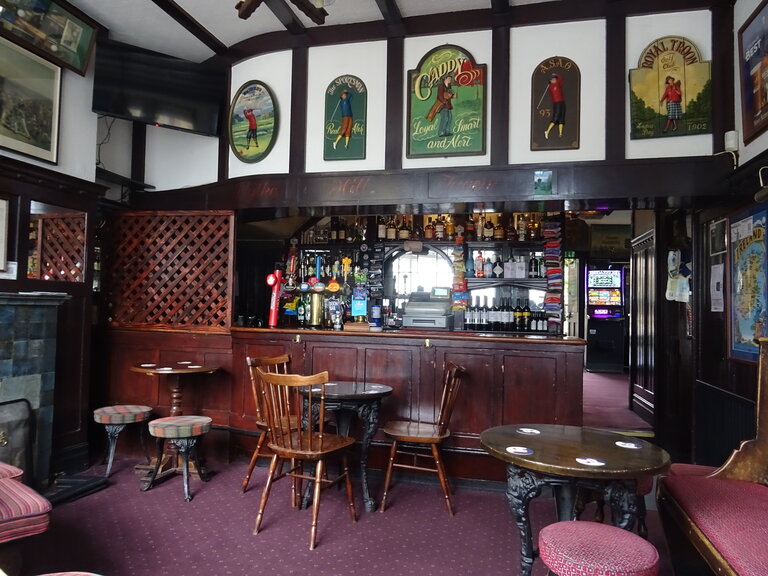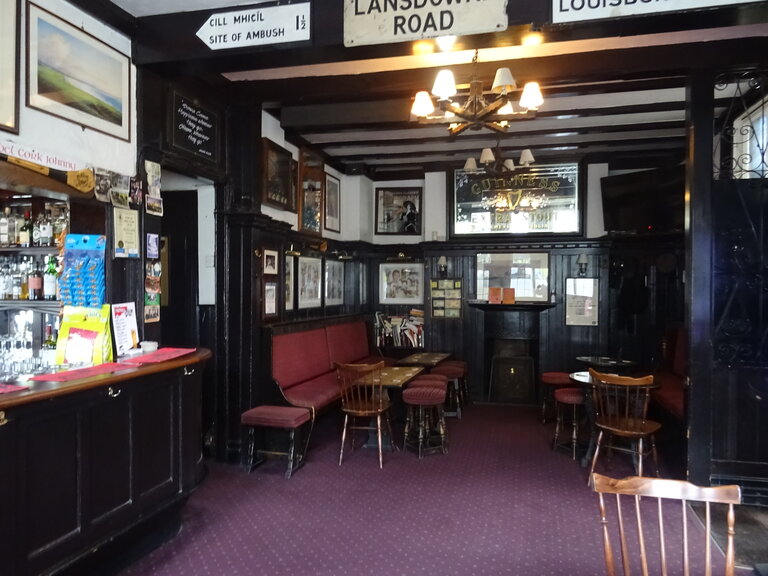Blythe Hill Tavern
319 Stanstead RdForest Hill
SE23 1JB
This pub is not only a grade II listed building, it is also a Three Star pub on the Campaign for Real Ale’s (CAMRA) National Inventory as having an interior of outstanding national historic importance, and the description is as follows: “A most appealing Victorian corner local, which was given a makeover probably in the 1920s. The exterior tilework of that time has, sadly, been painted over, but doesn’t spoil the enjoyment of the interior. There are still three separate rooms with a public bar on the corner, a saloon to the left and a large room running across the back of the pub. There was once a small snug at the back of the public bar entered by the now sealed double doors. The servery has an unusual T-shaped layout designed to create a counter in each of the rooms. The fittings are typical of their time – plain and undemonstrative in contrast to earlier Victorian exuberance. The counters have plain panelling and the bar-back is also modest but with Tudor arches under the lowest tier of shelves. All the ceilings have exposed beams – not the real thing though: they’re just nailed on to create an ‘olde worlde’ effect. Another sign that the refit was done on a low budget is the use of imitation wood panelling in all the rooms. The fireplaces are pleasing – the one in the rear room with a decorated metal hood and the one in the saloon with a grey-blue tiled surround and a tile with an improbable-looking sailing ship. Attractive benches in the saloon and rear room. An unusual feature is the way customers are free to walk across the serving area between the saloon and rear room.”
The listing description is as follows: “A public house, probably built around 1866 and refurbished internally in the 1920s or 1930s in the Brewer's Tudor style.
REASONS FOR DESIGNATION
The Blythe Hill Tavern and attached gate piers, probably constructed around 1866 and refurbished in the 1920s or 1930s, is listed at Grade II for the following principal reasons:
ARCHITECTURAL INTEREST:
* for the cohesion and modest quality of its ground-floor interior, which is a well-preserved example of the Brewer’s Tudor style that was popular in the inter-war period;
* for the good survival and visual interest of its exterior occupying a prominent position on the corner of Stanstead Road and Blythe Hill Lane.
HISTORIC INTEREST:
* for the survival and legibility of the three-room plan with multiple entrances, which effectively illustrates the tendency for inter-war pub designs to have distinct areas for different styles of drinking served by a central bar;
* as a good example of an inter-war refurbishment of a C19 pub, with the unusual T-shaped servery as a result of fitting three separate rooms into the pre-existing plan.
HISTORY
Until the late C19 the land either side of Stanstead Road consisted of open fields and market gardens, along with a few large houses of the early-mid C19 including Blythe House, Stanstead Villa and Stanstead Lodge (NHLE: 1079934; Grade II). In the 1860s and 1870s the area began to be developed with terraces of shops with accommodation above on either side of Stanstead Road. The Blythe Hill Tavern was originally known as the Blythe Hill Hotel; its name reportedly changed in the 1940s. The building first appears on Stanford’s Geological Library Map of London and its Suburbs published in 1878, along with the adjoining terrace of shops to the west. It does not appear on the 1:2500 Ordnance Survey (OS) map surveyed in 1868 and published in 1879, but the Blythe Hill Hotel is mentioned in several newspaper articles dating from 1866 onwards. This suggests the building had been completed by 1866 but was not recorded by the OS map survey until later in the C19. In the late C19 and the early C20 (until at least 1928) the Blythe Hill Hotel was associated with the Noakes & Co. Ltd brewery. The company was acquired by Courage & Co. Ltd in 1930 along with 120 tied houses, and it may be around this time that the Blythe Hill Hotel was refurbished in the Brewer’s Tudor style that survives consistently across its three main rooms in the form of ornamental ceiling beams and imitation wood panelling. The pub retains a number of freestanding benches carved with floral motifs that probably date from the same scheme. The only significant alteration since the 1920s or 1930s refit is the loss of the snug, which was previously positioned at the north end of the public bar and accessed by a set of double doors to the east elevation. The doors survive in situ but are now sealed. A new internal opening was formed in the cross-wall between the public and lounge bars after 1975. Plans attached to tenant’s deeds dated 1898 and 1915 depict stables and other outbuildings at the north end of the beer garden and a linear range of outbuildings along the garden’s west boundary. All of these have since been demolished. Until the late C20 the pub had metal lettering affixed to the bull-nose corner and a pub sign hanging from the south elevation. Both these features have been lost but the bracket for the pub sign survives.
DETAILS
A public house, probably built around 1866 and refurbished internally in the 1920s or 1930s.
MATERIALS
The pub has external walls of yellow stock brick laid in Flemish bond, with tiles to the ground floor now rendered over. The roof is covered with slates.
PLAN
The pub is trapezoid on plan, occupying a corner plot with an angled frontage facing south on to Stanstead Road and a bull-nosed south-east corner wrapping around to the secondary elevation facing east on to Blythe Hill Lane. The building has three storeys. The pub on the ground floor has three principal rooms: a public bar on the east side, a saloon bar to the west, and a large lounge bar spanning the width of the rear part of the building. The servery is T-shaped to create a bar counter in each of the three rooms. This unorthodox arrangement means that customers are permitted to cross the servery to move between the lounge and saloon bars. There are two floors of accommodation above the pub.
EXTERIOR
The principal, south elevation is three bays wide. The central bay comprises at ground-floor level a glazed and panelled door with a pediment supported on moulded consoles and, to the upper floors, a rendered, round-arched panel rising from the first floor to the second. The two outer bays have one window each per floor. The ground floor windows are canted bays which probably date from the 1920s or 1930s. They have metal glazing bars and are set back from the façade. All the doors to the ground floor are panelled, with frosted and leaded glazing to their upper halves, and probably also date from the 1920s and 1930s. The east bay window to the south elevation has one of these doors in place of its central pane. The first-floor windows are pairs of sashes divided by moulded pilasters, with a frieze, moulded cornice and pediment above, now partially covered with lead sheeting. The second-floor windows are smaller sashes with rendered architraves and slightly pointed heads. Positioned at first-floor level there is a bracket featuring a golden cockerel for the now-missing pub sign. Five brick chimney stacks populate the perimeter of the hipped, slate roof, which is obscured from street level by a brick parapet topped with a soldier course. The roof has a modern skylight inserted into its west slope and a modern, flat-roofed raking dormer to its east slope. The ground and first floors are separated by a moulded cornice and a painted fascia which both wrap around the south-east corner and extend the length of the east elevation. The south-east corner is canted at ground-floor level and bull-nosed to the first and second floors, the two upper floors clad in another rendered, round-arched panel. The east elevation to Blythe Hill Lane is four bays wide and has similar fenestration and doors to the south elevation, but there are just three windows to the first and second floors, and those to the first floor have a single sash each flanked by pilasters. The rear elevation faces north over the pub garden and has sash windows to the west of the first and second floors lighting the rear rooms. The ground floor has two flat-roofed extensions housing the ladies’ and gentlemen’s toilets, which have modern uPVC windows. The roof forms a gable end to this elevation.
INTERIOR
The pub was completely refurbished in the 1920s or 1930s with a Brewer’s Tudor treatment applied consistently across the three bar areas. All three rooms have ornamental timber ceiling beams and imitation wood panelling, which rises from skirting to picture rail height and features stanchions and moulded cornices of real timber which enclose Lincrusta-like panels embossed and painted to have the appearance of wood. The lounge bar has a fireplace to its west wall with a decorated metal hood. The fireplace in the saloon bar, also to the west wall, has a surround of blue and grey tiles and keystone painted with a sailing ship. The mirrored bar back shelves, which are of timber, in the public and saloon bars have Tudor arches beneath their lowest tier of shelves and a central, double-height mirrored panel set in a round arch. The bar counters in all three rooms have plain, fielded panelling and curved ends. The saloon bar counter has a later extension to the left which is slightly lower in height. In the eastern part of the lounge bar there is a carved, timber screen with a balustrade separating the corner seating from the side entrance to the pub. The toilets are located in the single-storey rear extensions and are accessed from the lounge bar. They have simple, panelled doors and tiled walls. The dogleg staircase leading to the upper floors is located behind the saloon bar counter, with its upper leg rising over the bar itself. The rooms on the first and second floor have been converted to dwellings.
SUBSIDIARY FEATURES
Attached to the east elevation there is a rendered wall and gate leading to the beer garden. The gate has piers of unequal height topped with spherical finials. The wooden gate itself appears to be a later replacement but the walls and gate piers date from the pub’s original construction.
SOURCES
Websites
Noakes & Co. Ltd, Brewery History Society Wiki, accessed 22 November 2021 from http://breweryhistory.com/wiki/index.php?title=Noakes_%26_Co._Ltd
Other
London Metropolitan Archives reference: ACC/2305/17/057, 'Blythe Hill Hotel, Stanstead Road, Forest Hill, Tenants Deeds'.
'Sales By Auction', The Times, 29 January 1867.
'Sydenham', Kentish Mercury, 3 August 1866.”
WhatPub link: WhatPub/Blythe Hill Tavern
PHG link: PHG/Blythe Hill Tavern
The Blythe Hill Tavern featured on the Daytime Crawl of South East London on 16 June 2007, the The Beautiful South: Daytime Crawl of Outer South East London on 22 October 2011, the Sunny Daze: Daytime Crawl of Petts Wood, Bromley, Catford and Forest Hill on 23 June 2012, and the Going to the Flicks: Daytime Pub Tour of Bellingham, Honor Oak and Forest Hill on 18 February 2023.
 Exterior
Exterior
 Public Bar
Public Bar
 Saloon Bar
Saloon Bar
 Rear Bar Counter
Rear Bar Counter
 Rear Bar
Rear Bar
